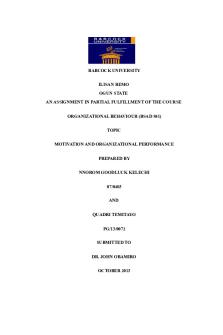Ethogram and Report on Canine Behaviour PDF

| Title | Ethogram and Report on Canine Behaviour |
|---|---|
| Author | Lauren Dowdeswell |
| Course | Canine Behaviour and Training |
| Institution | University of Chester |
| Pages | 9 |
| File Size | 556.1 KB |
| File Type | |
| Total Downloads | 54 |
| Total Views | 136 |
Summary
This is a report and ethogram of canine behaviour. It is to answer the question, does size affect the social interactions in dogs? It looks if a small dog is more likely to interact with a smaller dog or a larger dog and vice versa. ...
Description
RC4305 Introduction to Canine Behaviour
RC4305 – Scientific Report Template Student J Number:
J84811
Title: Does size affect social interactions in dogs? (1100 word count maximum) 1199 Introduction: Dogs are the oldest domesticated animal (Serpell, 2017), yet it can be hard to read their behaviour and body language. Due to issues like anthropomorphism, owners believe that their dog is displaying one behaviour, when they are actually displaying the complete opposite. It can be dangerous in social situations if owners cannot read their dog’s body language. Wolves had specific structures that they used for visual signalling, yet due to over-selective breeding, some breeds now struggle to display certain signals through their body language. For example, the Bulldog has very short legs “so that the dog cannot easily crouch”, meaning they cannot initiate play through a play-bow (Bradshaw, 2011). The ability for dogs to be able to communicate with each other is vital. Dogs are more suited to live socially, as they can learn things from one another, and this is key for their development (Hare & Woods, 2013). Dogs learn behaviours during socialisation as a puppy. When interacting with other puppies, they learn key lessons such as how to play and bite-inhibition (Söderström, 2019). But it is also important for them to interact with humans in this stage. This surely means that a dogs’ social behaviours can also be influenced by humans. A study about the behaviour of smaller and larger dogs (Arhant et al., 2010) found that smaller dogs were rated as more disobedient and excitable (Bennett and Rohlf, 2007, cited in Arhant et al., 2010), and in females, the smaller the size, the higher risk of biting (Guy et al., 2001, cited in Arhant et al., 2010). They understand this to be due to the fact that smaller dogs are seen as a lower risk factor, so they receive less formal training (Kobelt et al., 2013, cited in Arhant et al., 2010). While this may suggest that smaller dogs are more aggressive thus have poorer social skills, this study was completed using a questionnaire-based survey, which can cause a high level of
1
RC4305 Introduction to Canine Behaviour
bias. Also, the questionnaire results do not disclose whether these reactions were towards humans or other dogs, therefore the results are incomparable. Given the fact that some dogs like certain breeds but not others (Krieg, 2017), it is a possibility that dogs will act differently around different-sized dogs. Understanding why this is and warning signs through their social interactions is paramount to recognising whether a behaviour is friendly or threatening, therefore potentially preventing conflict. Project aim and hypothesis: Aim - to investigate if the size of a dog influences their social interactions with other dogs.
Hypothesis - there will be a relationship between the size of a dog and how they socially interact with other dogs. Methodology - Proposed Data collection and analysis (justified)*: A focal sample (Bosholn and Anciães, 2017) of 20 dogs will be used (small...
Similar Free PDFs

Canine hindlimb
- 2 Pages

Canine and Feline Skin Cytology
- 535 Pages

Canine muscles
- 2 Pages

Canine forelimb
- 2 Pages

Groups and Intergroup Behaviour
- 4 Pages

Neurotransmitters AND Behaviour
- 2 Pages

Organizational theory and behaviour
- 186 Pages

Canine forelimb 2
- 3 Pages
Popular Institutions
- Tinajero National High School - Annex
- Politeknik Caltex Riau
- Yokohama City University
- SGT University
- University of Al-Qadisiyah
- Divine Word College of Vigan
- Techniek College Rotterdam
- Universidade de Santiago
- Universiti Teknologi MARA Cawangan Johor Kampus Pasir Gudang
- Poltekkes Kemenkes Yogyakarta
- Baguio City National High School
- Colegio san marcos
- preparatoria uno
- Centro de Bachillerato Tecnológico Industrial y de Servicios No. 107
- Dalian Maritime University
- Quang Trung Secondary School
- Colegio Tecnológico en Informática
- Corporación Regional de Educación Superior
- Grupo CEDVA
- Dar Al Uloom University
- Centro de Estudios Preuniversitarios de la Universidad Nacional de Ingeniería
- 上智大学
- Aakash International School, Nuna Majara
- San Felipe Neri Catholic School
- Kang Chiao International School - New Taipei City
- Misamis Occidental National High School
- Institución Educativa Escuela Normal Juan Ladrilleros
- Kolehiyo ng Pantukan
- Batanes State College
- Instituto Continental
- Sekolah Menengah Kejuruan Kesehatan Kaltara (Tarakan)
- Colegio de La Inmaculada Concepcion - Cebu







